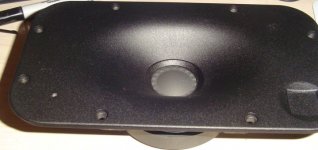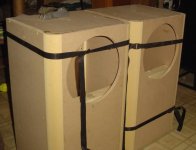Does anyone have any thoughts on the need for roundovers? One school of thought is that for a box of sufficiently narrow width, they're not really necessary; another dictates that they're required on the sides, while a third states that enormous roundovers along all four edges of the front of the loudspeaker are necessary to avoid baffle diffraction. Then there's the more extreme diffraction-control techniques, which include spherical enclosures and the use of waveguides. Does anyone have any thoughts on this issue?
I would not consider the use of waveguides "extreme."
[We've previously discussed this, tho.... ]
]
http://techtalk.parts-express.com/showthread.php?t=214805
[We've previously discussed this, tho....
http://techtalk.parts-express.com/showthread.php?t=214805
Last edited:
I would not consider the use of waveguides "extreme."
[We've previously discussed this, tho....]
How important is a roundover on the top and bottom? - Techtalk at Parts-Express.com
D'oh!
Well, it's officially been a long day...
In any case, I'm still curious about the use of JBL-style elliptical waveguide. I'm considering shelling out a rather good-sized lump of cash for some milled metal enclosures, and I figure that if I'm putting a big lump of metal in a milling machine, I may as well go nuts.
I'm wondering if it's possible to simply duplicate JBL's waveguide as used on the LR6328.
JBL :: Product
This would be aesthetically pleasing, eliminate any problems with diffraction, and potentially reduce distortion in the midrange.
I'm wondering if it's possible to simply duplicate JBL's waveguide as used on the LR6328.
JBL :: Product
This would be aesthetically pleasing, eliminate any problems with diffraction, and potentially reduce distortion in the midrange.
Why don't you just order a pair from JBL Pro?? All you need is a part number or where it's used to get them. Get the tweeters too so you don't have to worry about the transition to the waveguide.
Rob
I have a sneaky feeling my ScanSpeak 6600s are probably the better tweeter.
Also, no screw holes.
Incidentally, as you seem to have one and I don't, could you tell me the depth of the waveguide?
Last edited:
2" radius is the minimum for any meaningful diffraction control.
You need to do all four sides of the baffle.
Supporting data, references??
and milling the waveguide into the surface would look a lot better than having a funny-shaped piece of plastic inserted.
They are cast aluminum. You are going to go through the expense and time of generating a unproven waveguide in CAD and then importing it and going through a machine program conversion from the CAD file. Have fun.
I have a sneaky feeling my ScanSpeak 6600s are probably the better tweeter.
Why??
Incidentally, as you seem to have one and I don't, could you tell me the depth of the waveguide?
They are a inch deep but without the profile it's meaningless.
Rob
Supporting data, references??
Vance Dickason's The Loudspeaker Cookbook.
Supporting data, references??
It's wavelength dependent. These worked out well for me in a DIY cabinet. I used 2" and it is quite large. They have 3 and 4 as well.
Aitwood Anderson International - StoreFront
Rob
Attachments
What you don't know is that the transition from round to elliptical begins in the front plate of the tweeter....I have a sneaky feeling my ScanSpeak 6600s are probably the better tweeter.
2" radius is the minimum for any meaningful diffraction control.
There was a good article in aXp. Even a little bit helps, but to go appreciablly low 4" is a good target. As well a champher is pretty much as good as a round over.
dave
A bevel is very close to as good and is a lot easier to incorporate a large-scale beveled edge than roundover. 3/4 is definitely getting small for most of the bandwidth, but is still valuable to do, particularly for a tweeter section. I like to point out that the angle of incidence means that the wavefront sees a larger roundover the further from the driver it gets.
Sadly, there are people spreading misinformation about how large is needed. I just had an industry professional call me a troll and tell me I needed more book learnin' when I challenged his statement that "'Physical obstructions' must be at least a full wavelength in dimension, otherwise they are acoustically invisible." on another forum.
The misinformed are often aggressively stupid, and this topic seems to pull that type out of the woodwork.
Sadly, there are people spreading misinformation about how large is needed. I just had an industry professional call me a troll and tell me I needed more book learnin' when I challenged his statement that "'Physical obstructions' must be at least a full wavelength in dimension, otherwise they are acoustically invisible." on another forum.
The misinformed are often aggressively stupid, and this topic seems to pull that type out of the woodwork.
Last edited:
And I say, 3/4" is where "diminishing returns" start to kick in...
Get your hands on the aXp article...
dave
Excuse me Dave, do you mean AudioXpress?
( there have been several articles there on diffraction, and one that expanded on Olson's early work )
Syd
Can anyone point me to some good issues to purchase on the subject?
Thanks,
Dan
- Status
- This old topic is closed. If you want to reopen this topic, contact a moderator using the "Report Post" button.
- Home
- Loudspeakers
- Multi-Way
- Roundovers: How much do you need?

